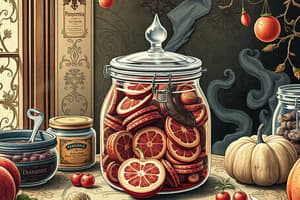Podcast
Questions and Answers
Food preservation does all of the following EXCEPT:
Food preservation does all of the following EXCEPT:
- Maintains nutritional value
- Promotes the growth of microorganisms (correct)
- Inhibits spoilage
- Extends shelf life
In degrees Fahrenheit, what is the temperature range of the Danger Zone?
In degrees Fahrenheit, what is the temperature range of the Danger Zone?
41 to 135
Reheated food items must be heated for a minimum of 15 seconds to at least:
Reheated food items must be heated for a minimum of 15 seconds to at least:
165° F
The preservation technique that attempts to remove moisture is:
The preservation technique that attempts to remove moisture is:
"Chilling" is most commonly practiced by:
"Chilling" is most commonly practiced by:
All of the following are Time/Temperature Control for Safety Food (TCS) EXCEPT:
All of the following are Time/Temperature Control for Safety Food (TCS) EXCEPT:
Bacterial contamination can spread quickly because if the conditions are right, bacteria can multiply in:
Bacterial contamination can spread quickly because if the conditions are right, bacteria can multiply in:
It is important that food servers are trained to know food ingredients because:
It is important that food servers are trained to know food ingredients because:
The best temperature for short-term refrigeration storage is:
The best temperature for short-term refrigeration storage is:
Which preservation technique involves heating foods to mild temperatures and then cooling them down immediately?
Which preservation technique involves heating foods to mild temperatures and then cooling them down immediately?
Flashcards are hidden until you start studying
Study Notes
Food Preservation and Safety Practices
- Food preservation aims to prevent the growth of microorganisms; promoting their growth is incorrect.
- The Danger Zone, where bacteria thrive, is between 41°F and 135°F.
- Reheated food items must reach a minimum temperature of 165°F for at least 15 seconds to ensure safety.
Preservation Techniques
- Dehydration is a method used to remove moisture from food, helping to inhibit microbial growth.
- Commercial food distributors primarily practice "chilling" to keep food safe during transport and storage.
- Pasteurization is a preservation technique involving heating foods at mild temperatures followed by rapid cooling.
Safety Food Guidelines
- Not all foods require strict Time/Temperature Control for Safety (TCS); processed garlic oil mixtures are an exception.
- Bacterial contamination can double rapidly under optimal conditions, with a potential growth time of 10 to 20 minutes.
Allergen Awareness
- Food servers must be knowledgeable about food ingredients to assist customers with food allergies effectively.
Refrigeration Standards
- For short-term refrigeration storage, the ideal temperature is below 41°F to keep food safe.
Studying That Suits You
Use AI to generate personalized quizzes and flashcards to suit your learning preferences.




